Mig T5142 from Gigabyte - the case-stand for the price of the monitor bracket
I want to offer the small-scale photo survey of a rather interesting computer case. What makes it interesting, it becomes immediately clear if you look at the photo. 
I stumbled upon it in search of a housing for a home media center, which was supposed to hang on the kitchen wall, so that there one could, for example, watch a movie or an IP-TV program. The main selection criteria were low noise and compact size. In addition, it was necessary to solve the problem of placing the monitor. I looked at the mITX-case with an external power supply unit and DC-ATX converter, and in one of the reviews I saw the T5142 MIB. A brief search showed that this building is for sale in Moscow, and when I visited the site of one of the companies, I found that this building costs half the price of an average ITX package that does not have a monitor clip. And even is available. Without losing time, I went and bought this building, and now I want to take a closer look at you.
As the seller told me, after I had checked when buying “the presence of mechanical damage”: “What can happen to him with such packaging?” We must pay tribute - the product is packaged for glory. Outside, this is a colorful cardboard box with a comfortable plastic handle (though, as I drove the purchase home, one edge of this handle broke and stopped holding on) ...
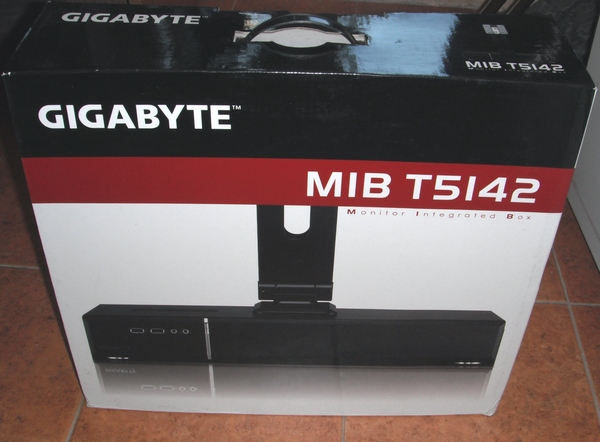
... which, in particular, describes the merits of this body and its characteristics ...
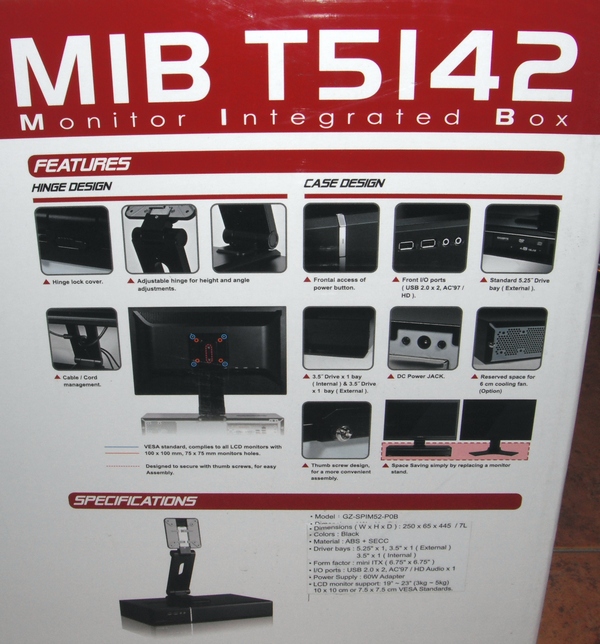
')
... and inside there is a monolithic foam block of two halves, protecting its contents, as well as instructions in a separate package.
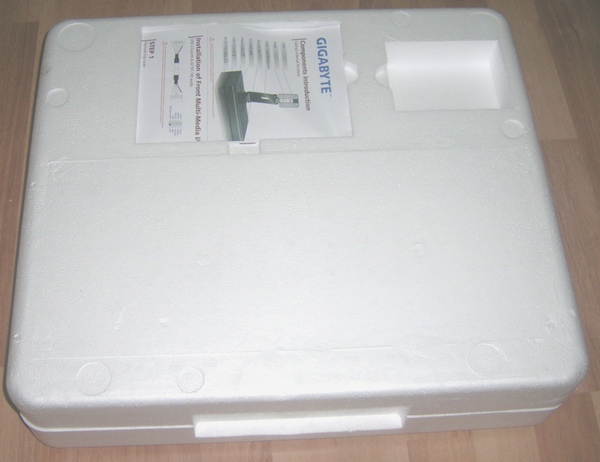
Inside the foam, in separate cells ...
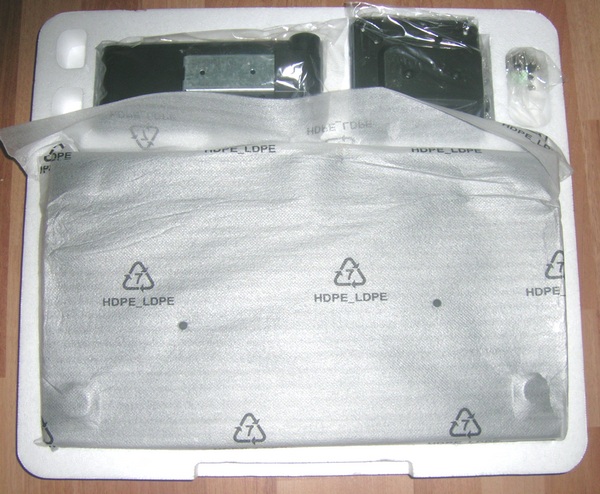
... are: the building itself,
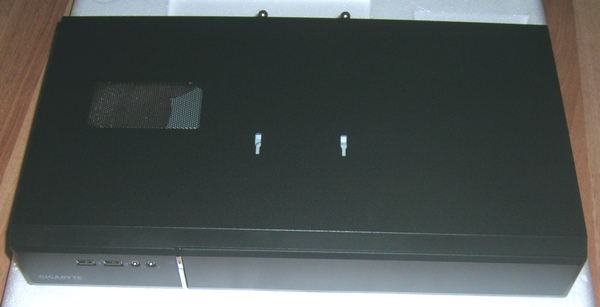
Monitor mount in two parts

external AC-DC power supply (60W),

bag with fasteners.
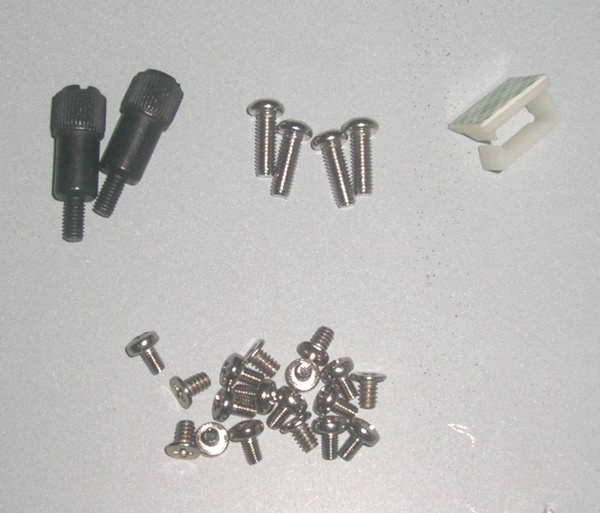
In the end, everything you need and nothing extra (read - do not have to overpay for unnecessary).
First I looked at the purchase outside. The top cover showed slots for mounting the bracket for the monitor and the ventilation grill above the processor and chipset heatsink.
On the front panel are two USB connectors and connectors for a mini-jack for headphones (speakers) and a microphone. On the beautiful silver vertical strip is a power button, equipped with a blue LED indicator. This housing has no other indicators.
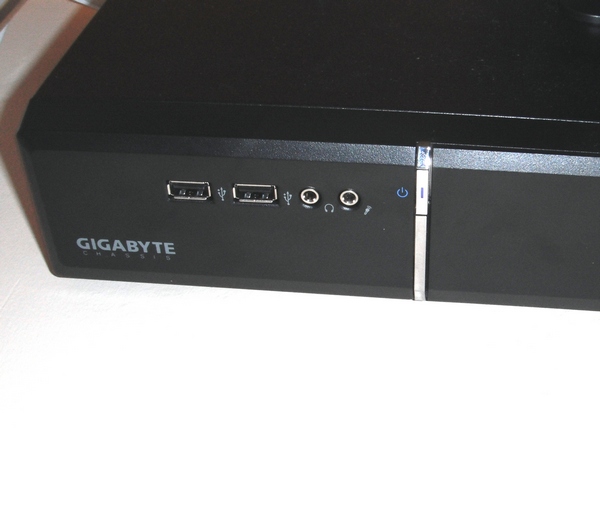
Most of the front panel is occupied by a flip cover, behind which are external compartments: 3.5 "and 5.25". The lid is fixed with magnets, so it fits snugly (no need to press to open) and perfectly holds in any position of the body.
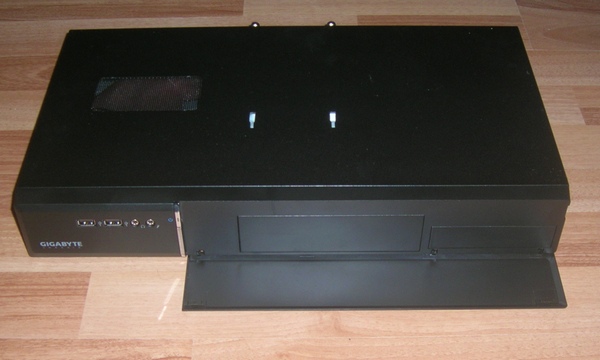
On the back wall there is a ventilation grille, designed for installation of a 60mm fan, as well as a cutout for the back panel of the motherboard.
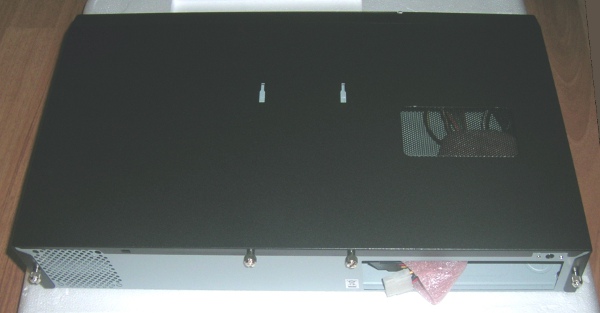
Below the case is on 4 round legs, fastened with screws (this will be important later).
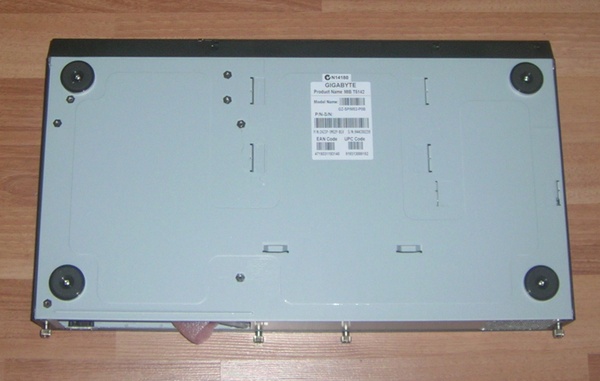
Go inside. The top cover is fixed with four screws in large knurled heads, so it is easy to remove it without a tool. Inside are found:


After removing the packaging from the wires, you can recount them:
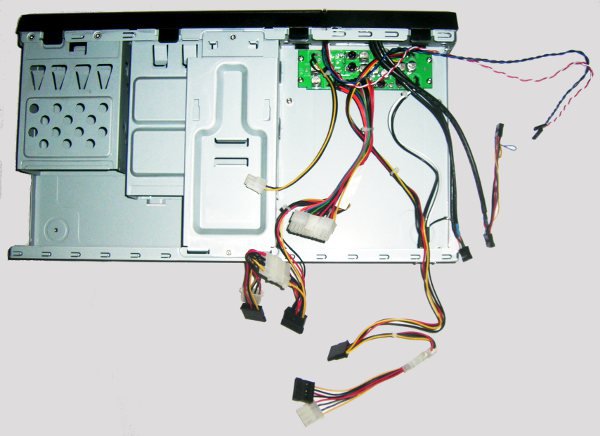
Considering how the motherboard will be placed, we note that the case DOES NOT INCLUDE the installation of expansion cards. Pay attention, for someone it will be essential. Although there is usually one PCI / PCIx slot on mITX-boards, it is impossible to insert a board into it and, moreover, to bring it to the rear panel, without substantial modification of the case it will not work.
Summarizing, again everything you need and nothing more. It would be nice, of course, to get a 24-pin ATX-connector, but apparently the manufacturer decided that the converter power is not enough to meet the new standard (although there are boards that require power to 24 pins, perfectly fit into the declared power).
Those who are interested only in the review of the corps may stop reading, starting from this place, and go to the store (if, of course, the corps interested you). Then I want to talk about how I made a media center based on this corpus, and those who read my previous story about the industrial corpus know that I will not be stopped by the need to modify the computer hardware with a drill and jigsaw (or even a grinder) in general, I warned :)
There were three tasks that I had to solve with tools that were not quite traditional for computer scientists: put two HDDs in a housing, take care of cooling and hang the whole structure on the wall.
Putting two discs in a close, honestly speaking, basket of 3.5 ”seemed unreasonable to me, despite the fact that an empty five-inch compartment stood idle. Since the “branded” sled 5.25 ”to 3.5” was not at hand, the easiest thing was to secure the disk on one side in a regular manner, and on the other on a steel corner. Simply, firmly, unnoticeable outside.

For the media center, I used a Celeron-based D201GLY2 board. This board, though without a processor cooler, will not survive without blowing, especially since I did not find the driver for FC13 for the embedded video, and vesa loads the processor to full when playing movies and it heats up quickly. The simplest solution turned out to be to remove the grille on the top panel (it is mounted on curved petals, so this solution is reversible) and fix the cooler 60 * 60mm in the hole formed. I didn’t even have to drill anything, the screws with washers squeezed perfectly by the edges. The only thing required is a little tumbling to connect the cooler connector to the motherboard when installing the cover. The noise is minimal, in contrast to the option “fix the cooler on the radiator”, since the fan is very tough and there are no obstacles to the air flow.
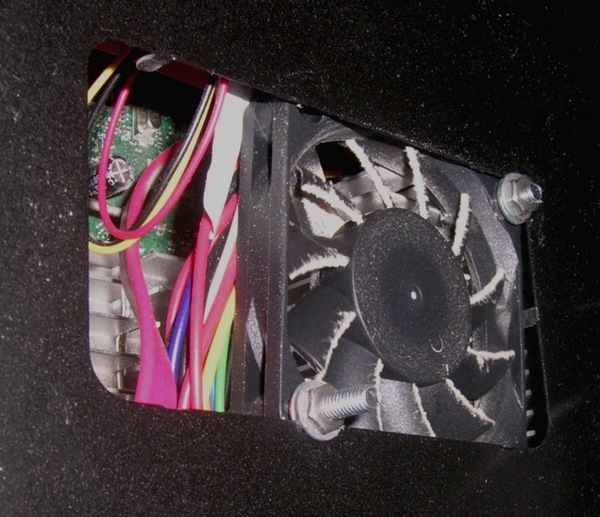
Finally, I wanted the whole structure to hang on the wall. I had to take up heavy equipment and from the steel strip to make a mount for the case (securing it for the holes for the rear legs and for the additionally drilled holes closer to the center) and small active speakers. With a total construction weight of about 10 kg (with a plate, screws, and an old 15 ”monitor), everything fits perfectly on two dowel screws. Unfortunately, I didn’t find the photo of the “rear view” in my room (I probably forgot to do it), so I’m citing only the view of the whole assembly in its place.

By itself, the case, in my opinion, is a unique option that is suitable for the assembly and media center and medium-sized workstation (on modern low-power processors), which will look great in any interior. I had no complaints about the quality of workmanship, and the price of this product, which, as I wrote in the title, is comparable to the average price of the monitor mounting bracket to the wall, will not allow the “toad” to influence your purchase decision.
The choice is yours, dear habro users, I hope my review has helped you with this.

I stumbled upon it in search of a housing for a home media center, which was supposed to hang on the kitchen wall, so that there one could, for example, watch a movie or an IP-TV program. The main selection criteria were low noise and compact size. In addition, it was necessary to solve the problem of placing the monitor. I looked at the mITX-case with an external power supply unit and DC-ATX converter, and in one of the reviews I saw the T5142 MIB. A brief search showed that this building is for sale in Moscow, and when I visited the site of one of the companies, I found that this building costs half the price of an average ITX package that does not have a monitor clip. And even is available. Without losing time, I went and bought this building, and now I want to take a closer look at you.
Unpacking, picking overview
As the seller told me, after I had checked when buying “the presence of mechanical damage”: “What can happen to him with such packaging?” We must pay tribute - the product is packaged for glory. Outside, this is a colorful cardboard box with a comfortable plastic handle (though, as I drove the purchase home, one edge of this handle broke and stopped holding on) ...

... which, in particular, describes the merits of this body and its characteristics ...

')
... and inside there is a monolithic foam block of two halves, protecting its contents, as well as instructions in a separate package.

Inside the foam, in separate cells ...

... are: the building itself,

Monitor mount in two parts

external AC-DC power supply (60W),

bag with fasteners.

In the end, everything you need and nothing extra (read - do not have to overpay for unnecessary).
We study the device
First I looked at the purchase outside. The top cover showed slots for mounting the bracket for the monitor and the ventilation grill above the processor and chipset heatsink.
On the front panel are two USB connectors and connectors for a mini-jack for headphones (speakers) and a microphone. On the beautiful silver vertical strip is a power button, equipped with a blue LED indicator. This housing has no other indicators.

Most of the front panel is occupied by a flip cover, behind which are external compartments: 3.5 "and 5.25". The lid is fixed with magnets, so it fits snugly (no need to press to open) and perfectly holds in any position of the body.

On the back wall there is a ventilation grille, designed for installation of a 60mm fan, as well as a cutout for the back panel of the motherboard.

Below the case is on 4 round legs, fastened with screws (this will be important later).

Go inside. The top cover is fixed with four screws in large knurled heads, so it is easy to remove it without a tool. Inside are found:

- DC-DC converter board, from which several bundles packed in soft polypropylene extend,
- removable baskets for mounting drives (one for 3.5 ”, the other for 5.25”),
- removable jumper that stiffens the whole body and holds the monitor bracket (note the cutouts in the jumper, repeating the cutouts on the top cover).

After removing the packaging from the wires, you can recount them:

- ATX connector for 20 pins,
- Additional 4-pin connector 12VDC,
- Two identical bundles with connectors for powering hard drives, Molex and SATA, plus two Molex splitters for Molex + SATA. Enough to power the drives in any combination.
Considering how the motherboard will be placed, we note that the case DOES NOT INCLUDE the installation of expansion cards. Pay attention, for someone it will be essential. Although there is usually one PCI / PCIx slot on mITX-boards, it is impossible to insert a board into it and, moreover, to bring it to the rear panel, without substantial modification of the case it will not work.
Summarizing, again everything you need and nothing more. It would be nice, of course, to get a 24-pin ATX-connector, but apparently the manufacturer decided that the converter power is not enough to meet the new standard (although there are boards that require power to 24 pins, perfectly fit into the declared power).
We collect media center
Those who are interested only in the review of the corps may stop reading, starting from this place, and go to the store (if, of course, the corps interested you). Then I want to talk about how I made a media center based on this corpus, and those who read my previous story about the industrial corpus know that I will not be stopped by the need to modify the computer hardware with a drill and jigsaw (or even a grinder) in general, I warned :)
There were three tasks that I had to solve with tools that were not quite traditional for computer scientists: put two HDDs in a housing, take care of cooling and hang the whole structure on the wall.
Putting two discs in a close, honestly speaking, basket of 3.5 ”seemed unreasonable to me, despite the fact that an empty five-inch compartment stood idle. Since the “branded” sled 5.25 ”to 3.5” was not at hand, the easiest thing was to secure the disk on one side in a regular manner, and on the other on a steel corner. Simply, firmly, unnoticeable outside.

For the media center, I used a Celeron-based D201GLY2 board. This board, though without a processor cooler, will not survive without blowing, especially since I did not find the driver for FC13 for the embedded video, and vesa loads the processor to full when playing movies and it heats up quickly. The simplest solution turned out to be to remove the grille on the top panel (it is mounted on curved petals, so this solution is reversible) and fix the cooler 60 * 60mm in the hole formed. I didn’t even have to drill anything, the screws with washers squeezed perfectly by the edges. The only thing required is a little tumbling to connect the cooler connector to the motherboard when installing the cover. The noise is minimal, in contrast to the option “fix the cooler on the radiator”, since the fan is very tough and there are no obstacles to the air flow.

Finally, I wanted the whole structure to hang on the wall. I had to take up heavy equipment and from the steel strip to make a mount for the case (securing it for the holes for the rear legs and for the additionally drilled holes closer to the center) and small active speakers. With a total construction weight of about 10 kg (with a plate, screws, and an old 15 ”monitor), everything fits perfectly on two dowel screws. Unfortunately, I didn’t find the photo of the “rear view” in my room (I probably forgot to do it), so I’m citing only the view of the whole assembly in its place.

findings
By itself, the case, in my opinion, is a unique option that is suitable for the assembly and media center and medium-sized workstation (on modern low-power processors), which will look great in any interior. I had no complaints about the quality of workmanship, and the price of this product, which, as I wrote in the title, is comparable to the average price of the monitor mounting bracket to the wall, will not allow the “toad” to influence your purchase decision.
Advantages:
- convenient combination of the case and monitor stand;
- plenty of storage space;
- good workmanship and reliable packaging;
- attractive price (bought in September of this year for 1195 rubles).
Disadvantages:
- few indicators;
- the impossibility of installing expansion cards;
- not the highest power converter power (there are 120 W);
- may have to work on the problem of cooling.
The choice is yours, dear habro users, I hope my review has helped you with this.
Source: https://habr.com/ru/post/109986/
All Articles